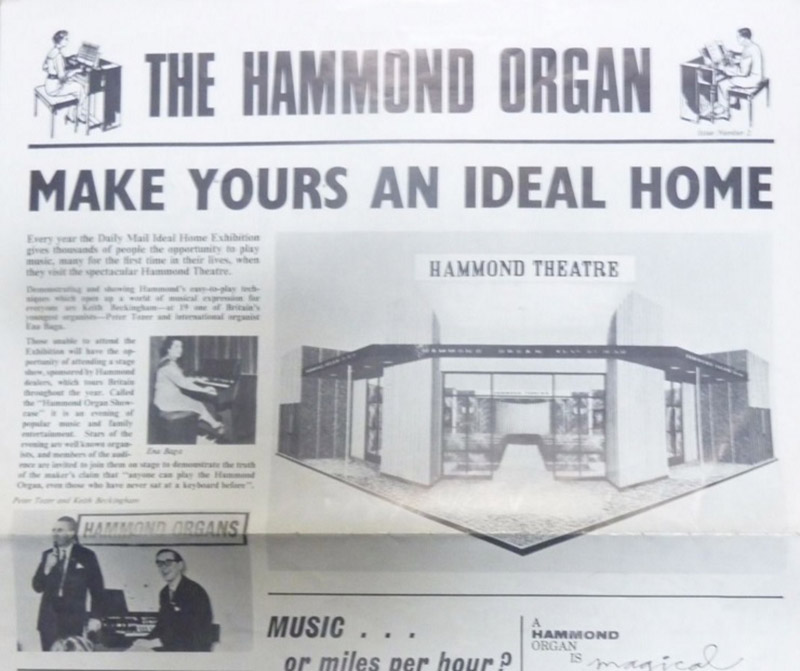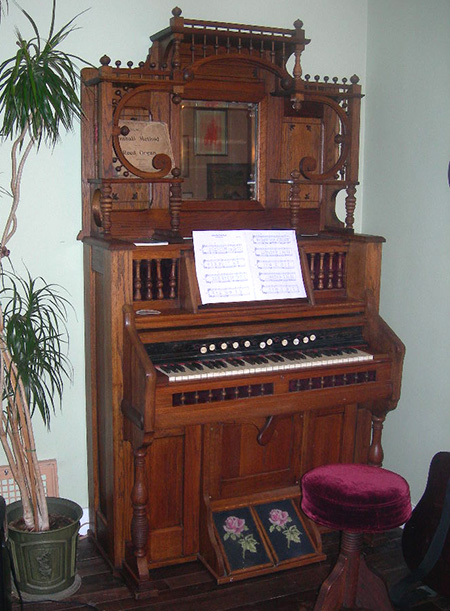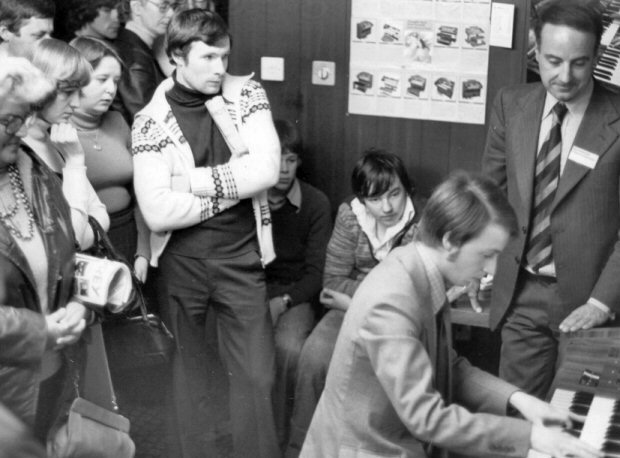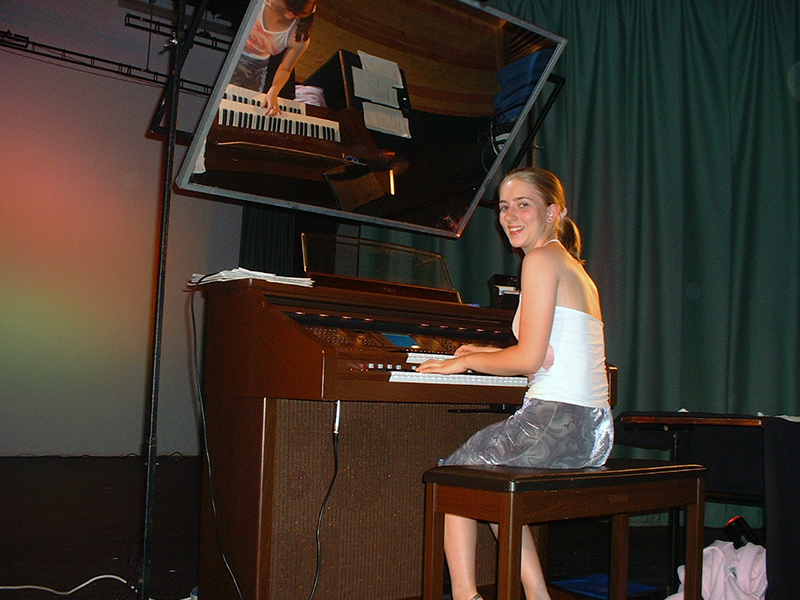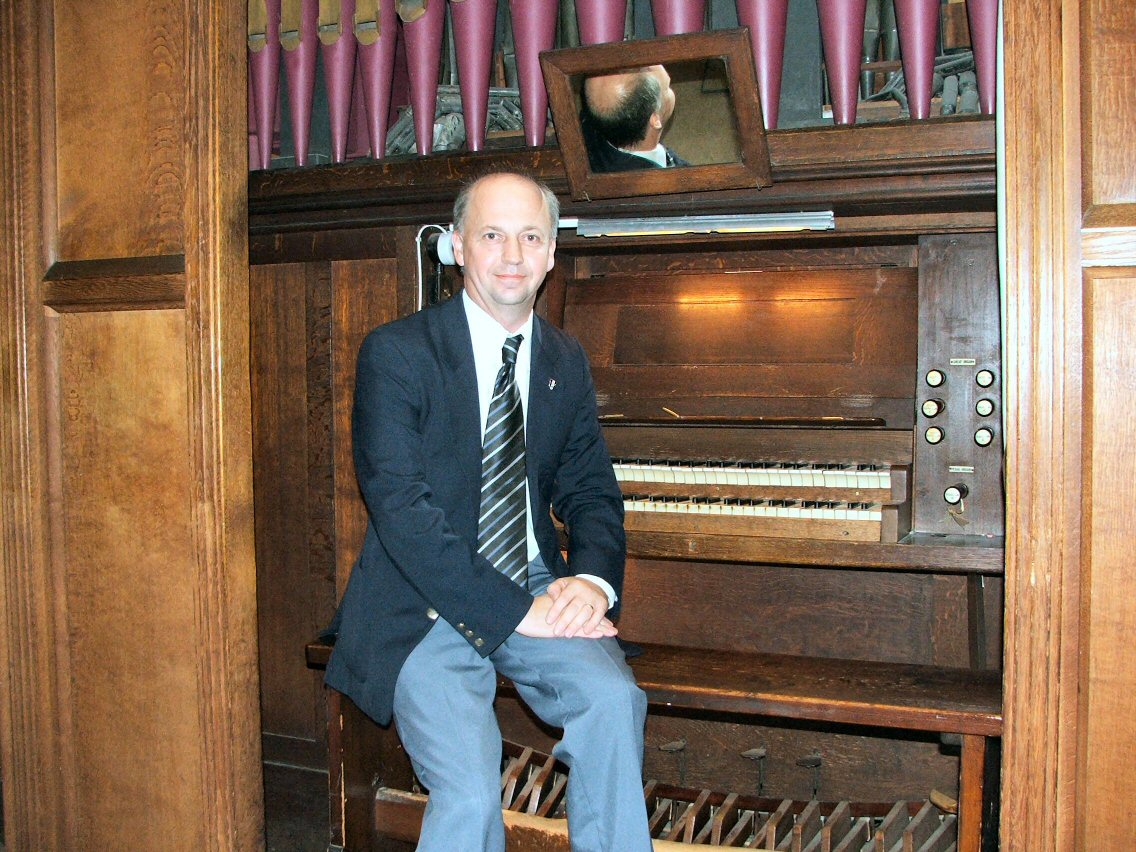Biography
They tell me that I’ve always been musical! Well, I can certainly remember singing in both the school and church choirs from an early age and I was recently reminded of the fact that I used to sing the latest pop songs at the top of my voice walking to and from my primary school each day when I was a very young lad. Thankfully it was only a five minute walk from home and no recordings exist of my vocal 'performances'!
At first, organ music was just something that I heard or sang with in church every Sunday or for special services such as Easter and Christmas, but when I was around 8 or 9 years old my Dad took me to the annual “Schoolboys’ Exhibition” held at London’s Olympia. This was a huge event and a great attraction for many young boys, with all sorts of technological wonders on show. It was here that I first heard the Hammond organ being played in the 'Hammond Theatre', by one of Hammond UK’s star demonstrators, the well-known theatre organist Ena Baga - you can just see her photo at the top left of the Hammond Exhibition Stand image below.
The Hammond Exhibition Stand.
Inspired by the Hammond’s big sound, at the very next opportunity, I sat down at the old Kimball reed organ that sat unused (and slightly broken!) in the corner of my Grandmother's living room, pulled out some stops like 'Diapason Forte' or 'Vox Humana' (not having the slightest idea what the names meant, of course!), pumped away at the pedals and started to bash out a ‘tune’ or two at the keys. I’m sure it must have sounded awful, but amazingly no one ever told me to stop!
A Kimball reed organ, just like my Grandmother's.
A short while later, my older sister Elizabeth started work at the East Sussex County Music School in Lewes and received the ‘perk’ of free piano lessons. When she practised, I would sometimes ‘sit in’ with her, watching and listening carefully, and then I’d sit at the piano and simply play what she had been working on. This playing was all by ear at first, of course, but I soon started to read the music too, making the vital connection between the ‘dots’ and the keys. The piano lessons were soon shared between Elizabeth and me but after a short while, when it was realised who was going to be the better player, they were transferred to me on my own. I then received what I would describe as a very strict, ‘classical’ piano education from Miss Margaret Moyes, who was one of Newhaven’s two ‘proper’ piano teachers back then. After three years, I’d reached Grade 6 but the electronic organ was about to make a major reappearance in my life.
One Saturday lunchtime my Dad took me for a trip out in the car and on the way back we popped into the Newhaven Railway Club for a beer. Well, a beer for Dad and a glass of Coke and a bag of crisps for me! I saw and heard a small combo organ being played on stage and once again I was impressed by the big sound that this tiny instrument could make. Not long after this, Dad discovered that a Hammond organ was being played every Saturday at another local social club and, given my obvious interest, took me along one evening, which was to be the first of many! The organist was a real gentleman by the name of Cliff Mulley, and he kindly let me sit right behind him on a high bar stool, as he played his trusty Hammond model T100, giving me the opportunity to listen, watch and learn.
On one of his visits to the club, he gave me a flyer with details of a ‘Hammond Organ Showcase’ concert to be staged by the Brighton Hammond Organ dealer, Lyon and Hall, at the famous Dome concert hall, in Brighton. This concert was to star the UK’s ‘Mr Hammond’, Keith Beckingham, and the internationally known theatre organist George Blackmore, and it would feature the fabulous and rare (only 1000 produced in total and rarer still in the UK, where less than 50 were imported) Hammond model X-66 organ. My Dad took me along for the evening and it was Keith Beckingham who opened the show on the Hammond T200 with Never on a Sunday. I think it was then that I started to realise how sharp my musical ‘ear’ was, as I could remember almost every note he played – indeed I can probably still play that exact arrangement! The second half of the evening was given over to George Blackmore with a virtuoso performance on the amazing X-66. He opened up with the rousing overture from Zampa and when the applause had died down he asked “Can you hear it OK at the back?” When the reply came back as “Yes!”, he pointed to the two large Hammond 12-77 speaker cabinets right next to the X-66 organ and, to much laughter, replied “You should try sitting here then!” And that, as they say, was that. I was well and truly ‘hooked’!
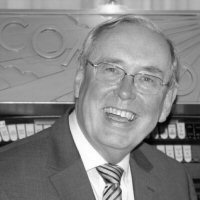
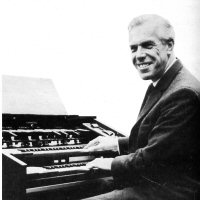
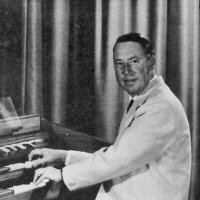
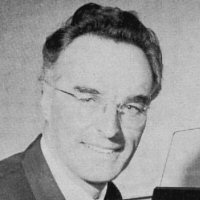
Clockwise from top left: Keith Beckingham, George Blackmore, Harold Smart, Jackie Brown.
It was only a week or so later that we went on a family shopping trip to Southwick Square, near Brighton. Mum and I were in Woolworths when Dad came in and said that there was a big organ dealership right next door. At first I thought he was kidding, but he was right! This was the Southwick branch of the Southern Organs chain so we went in and had a look. There was row upon row of organs of all shapes and sizes – I’d never seen so many in one place before! We didn’t buy an organ that day, but we did come away with a Hammond X-66 LP record (that was 'Hammond Continental', featuring Belgian virtuoso Jan de Nef, which I still have and enjoy listening to!) and we were given tickets for another big show at the Dome, this time featuring UK organ stars Harold Smart, Douglas Reeve and Jackie Brown at the latest Thomas organs, such as the 'Celebrity' and 'Trianon'. After seeing that show I just knew I had to start playing properly. Alas, having an organ at home was out of the question for the moment as my parents had only just paid out a lot of money to buy me a new piano and a guitar. Cliff Mulley suggested that I learnt accordion to get used to sustained melody notes and, after successfully starting with a small 32 bass instrument, I was soon upgraded to a great sounding Italian 120 bass model. I would practise in my bedroom and then, so I'm told, I would 'serenade' my sister and parents from the top of the stairs!
I suppose that I must have been about 13 when I first actually played an electronic organ, as opposed to just listening. This was a tiny Hammond VS100 Cadette, and was back at the Brighton Hammond dealer, Lyon and Hall. After listening for a short while, one of the shop’s organ teachers, UK cinema organist Bobby Pagan, came across and asked how long I’d been playing. I think I probably said something like “Ten minutes.” No, he said he wanted to know how long overall, and was most surprised when I told him that this was my first ever time at an organ.
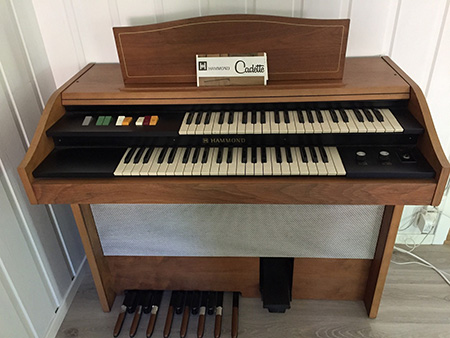
The Hammond Cadette
Bobby Pagan then swiftly moved me across to the much larger T200 model. Now this was basically the same organ that I’d been watching Cliff Mulley playing, so I sort of knew how it worked, and I remember that I actually managed to set up my own sounds. I also clearly remember Bobby switching off the organ's Leslie speaker, saying that it was a horrible thing. Bobby would become a firm friend and mentor, and we would often wind each other up about the merits and demerits of Leslie speakers in the coming years. I loved them, he hated them!
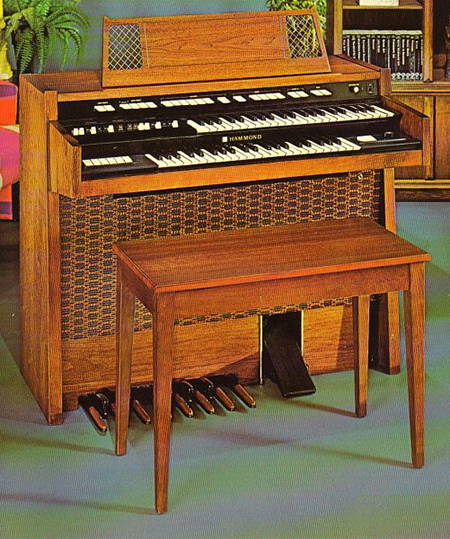
The Hammond T200
My playing, though it must have been very basic, attracted something of a crowd and, spotting the mileage in this, the shop's manager, Phil Baldwin, told me that I could come in and play whenever I wanted. I took him up on the offer – almost every Saturday – playing everything in the shop from the biggest Hammonds to the smallest Yamahas and even Philicordas! By then I was going to all the local organ concerts and demonstrations, and also regularly visited Southern Organs in Southwick. Once they realised I could play, they too invited me to come in to make some music. Their ‘musical director’ Jackie Brown said that l had the happy knack of getting good sounds out of whatever organ I played, so I was able to add Conn, Lowrey, Baldwin, Wurlitzer, Farfisa and Thomas to my ‘playlist’.

Southern Organs Southwick
It was about this time that Dad discovered that there was a large Gulbransen President organ at a hotel in Hove, so one day we paid a visit and Dad asked the manager if I could have a go. He wasn’t that keen but reluctantly agreed to let me have a few minutes at the organ, with the rider that if I couldn’t play properly I’d be off in moments. Well, I ended up playing for over twenty minutes and was invited back to play at the weekend....and the weekend after, and so on! Less than six weeks later, I was amazed to find that they wanted me to become the hotel’s resident organist. I gladly accepted the offer. I was officially too young to be allowed in licensed premises, let alone work in them, so I became ‘16 years old’ a bit early! It was clear that I needed to learn a lot more music in a very short space of time and I’d also have to practise a lot more, so Dad bought a Gulbransen Pacemaker for me to play at home, joking that ‘I could pay him back when I turned professional’.
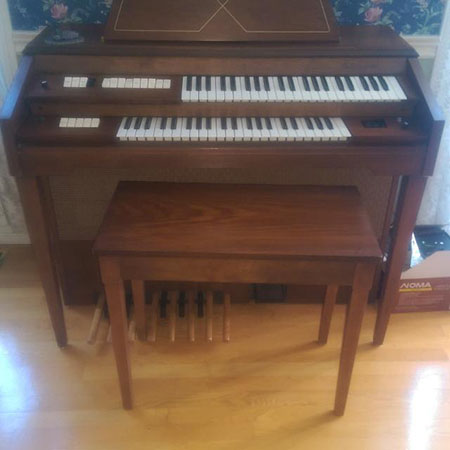
The Gulbransen 2102 Pacemaker, just like mine
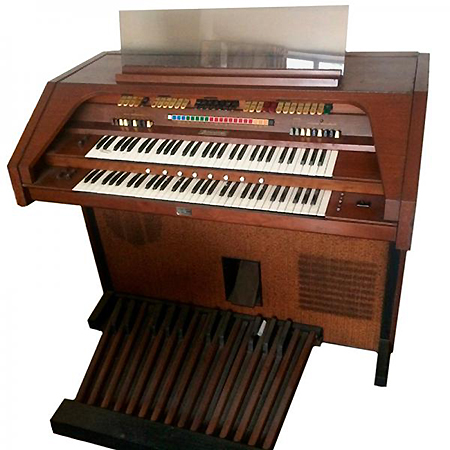
The Gulbransen 2134 President
The extra organ practice required for al of this soon affected my piano playing and it was time to come clean with my piano teacher, Miss Moyes. She wasn’t at all pleased, as she didn't really like organ at all and the look on her face told me that she probably thought that electronic organs like the Hammond and Gulbransen were the Devil's own work! I nevertheless continued on with piano studies with her, working my way up through the higher grades.
I also received a fair amount of organ mentoring – in classical, theatre and electronic styles - from Jackie Brown and Bobby Pagan. Dad did once ask Jackie if I could have lessons with him. He declined, saying that I was already playing well and would find my own style. He didn't want me to be a Jackie Brown 'clone'. But he was nevertheless a huge influence and I learnt an awful lot from him. Bobby's style of playing was quite different to Jackie's and I recall the way he would sigh and roll his eyes when I played something for him in Jackie's style! Never once, though, did he tell me not to do it and he'd usually say something like "The audience are going to love that, keep it in!"
I’d often heard the late, great Brian Sharp play his fantastic orchestral style arrangements on the weekly BBC Radio 2 programme ‘The Organist Entertains’, presented at the time by Robin Richmond, and went to see him play some Gulbransen organs in concert in early 1972. After the show, my Dad spoke to Arthur and Peter Butler, the UK Gulbransen importers, saying that I had one at home. They promptly sat me down at the new Theatrum model and I played a few tunes for them including Aquarius, from the musical Hair. That immediately brought Brian across to the organ as he wanted to know who was ‘playing one of his tunes’, and I got to ‘swap notes’ with him on the piece, not realising that he, along with almost all of my ‘idols’, was to become a firm friend in years to come. I guess Peter and Arthur Butler must have been impressed too as they filed my name away for later.
In the light of subsequent events for both Brian Sharp and myself, it’s worth pointing out that this was the first time either of us had seen a Kawai organ. The Butlers had only just started importing them and had brought one small model along. Brian didn’t (or, probably more likely, wouldn’t) play it, so that was left to the Southern Organs staff, and the sound that it made was dire. It’s just as well that they had improved immensely by the mid 1970s, then!
I’ve just added a new instalment of ‘It shouldn’t happen to an organist’ to the downloads page that tells the story in more detail, along with some other tales of working with Brian.
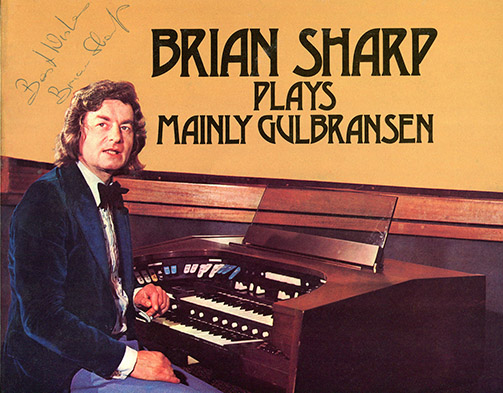
Brian Sharp at the Gulbransen Theatrum
My first real job in the music business came later in 1972, as the ‘Saturday Boy’ in Lyon and Hall, the same music shop where I first played that little Hammond organ. The photo below shows the shop’s piano department maybe 20 years or so before I started working there. Not an organ in sight yet, they only arrived in the 1960s, but to be honest things hadn’t changed that much by the time I arrived. The metal frame chair in the photo was the very same one that I sat on at my desk, which is the one right in front of the chair, with music books on! One of the first tasks I was was set was to repaint every wall in the department and to carefully scrape off all the lettering seen on the windows with a razor blade! Working in every department of the shop, from sheet music sales to piano and organ demonstrating, Hi-Fi and TV and even LP and cassette sales, was a good grounding in the music business which, as I soon discovered, was very different to simply playing the organ! Phil Baldwin handed me a well-thumbed copy of the American Wurlitzer Sales Manual and told me to ‘read, learn and inwardly digest it', but it was way too aggressive in its hard sell techniques, and to I had to tame it down a lot for UK use. I later came across the book a few times with different makers’ names on, it seemed to have been written just the once, then slightly customised as required.
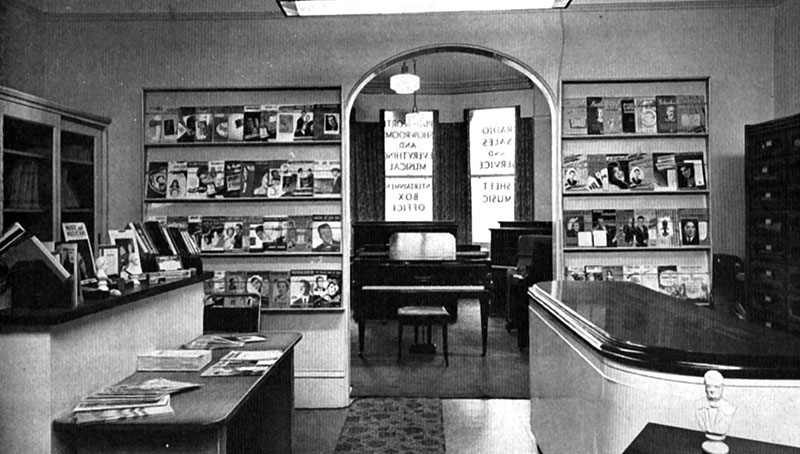
Lyon and Hall, Brighton, in the 1950s
The combination of playing at the hotel and working in the shop was to carry on throughout my remaining years at school, but I still carried on with my piano and organ studies. In September 1973 I was appointed resident organist at the rather larger Peacehaven Hotel, which was much nearer to my home, and I bought my own Hammond T500 organ and Leslie 145 speaker to use there. I also surprised my Dad by repaying him in full for the Gulbransen Pacemaker that he'd bought me – the princely sum of £375 - but I managed to sell it on sometime later for £450 - one of the few organs I've ever sold at a profit!
The Peacehaven Hotel, where I played Hammond organ in the early 1970s.
After a busy season at the Peacehaven Hotel playing solo and with a local vocal duo, and with the Hammond and Leslie paid for as a result, I was approached by Arthur and Christine Dudman, the then owners of the Cresta Yacht Club in Newhaven, and I took on the position of their resident organist, playing at weekends and holidays. They already had a Hammond T400 and Leslie 147, so I'd take along a couple of my own keyboards for extra sounds. This was great gig for me. Not only was it five minutes from home, but I'd be playing the organ next to a large panoramic window overlooking the southern end of Newhaven Harbour, where my Dad would sometimes be towing large ships in and out with the tug 'Meeching'. A wave to each other while we did our evening's work was the 'norm' and dad would then come in to listen later on nd then drive me home. Another local club then approached me for my 'spare' Friday nights and I played their Lowrey GAK-H1, a lovely sounding organ, but they were always telling me to 'play softer'. On my very last night there I took along my Leslie 145 speaker and I let rip. The very same people were then telling me that they'd never heard the organ sound so good - you just couldn't win with them!

The Cresta Yacht Club set up of Hammond T400 and keyboards
It was around this time that I started to play theatre pipe organ, and I got to know instruments like the Wurlitzers at the Granada cinemas in Kingston on Thames and Welling, the much bigger Wurlitzer at the Gaumont State, Kilburn, the Comptons at the Odeon, Leicester Square in London, the Granada, Sutton and the ABC, Plymouth, as well as the lovely Christie at the Granada, Walthamstow. It wasn’t long before I started playing organ concerts on some of the London Granada organs for the Theatre Organ Club, as well as for local organ societies on various makes of electronics.
At the Gaumont State, Kilburn Wurlitzer
One of my Dad’s friends was a local TV and radio news reporter, David Clitheroe. He had taken a regular interest in my music and, in addition to writing some newspaper articles about me for the local press, he interviewed me a couple of times on the radio. This led to my meeting BBC Radio Brighton producers Keith Slade and Stuart Hobday, and they gave me two half-hour organ music slots on the station’s ‘Music For You’ light music programme. These went down well and as a direct result the producers asked me to co-present ‘At The Console’, with three other well-known local organists, John Mann, Douglas Reeve and Bobby Pagan. This was to be a new light organ music programme that became very popular on local radio, eventually running for well over ten years and, although the four ‘core’ organists always remained the same, we were occasionally joined by other local organists such as Dickie Lord, Peter Larson and Linda Bayfield. Some of my broadcasts were copied to other BBC local stations and also to BBC Radio 2, where Robin Richmond used them on ‘The Organist Entertains’. The cheques for the ensuing ‘repeat fees’ were often unexpected (and always sadly very small) but nonetheless welcome!
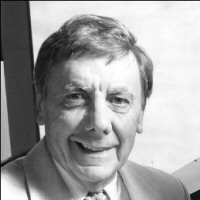



Clockwise from top left: John Mann, Douglas Reeve, Linda Bayfield, Bobby Pagan.
After our first meeting, Peter and Arthur Butler had kept an eye on my progress. Peter had popped into Lyon and Hall a couple of times for a chat, and I had done a little ad-hoc (and always unpaid!) demo work for them from time to time. In August 1976, I remember that I spent one very busy afternoon on their stand at the London Music Trades Fair, playing and demonstrating their Kawai E500 model and some WLM portable models. It was supposed to be a day out in London with my girlfriend with just a fleeting visit to the Trade Fair! Thankfully, she was also interested in electronic organs and didn’t mind a bit. Was this something of a test for me, I wondered? Well maybe it was because in July 1977 Peter called me and asked me to work for him for a whole week, again at the London Music Trades Fair. I would be demonstrating their entire new line of Kawai organs and synthesizers – and this time I would be paid! The week went very well and he subsequently invited me to do some more work for the company - providing I could drive to the various venues. I was still taking driving lessons at the time, so I had to pass my driving test – and do so as soon as possible!
Well, I passed the test just a few weeks later and within three days of that I started my Kawai travels with a trip up to Essex for a demo and mini-concert, followed by a visit to a Kawai dealer in Hastings later in the week for an in-store show. Not long afterwards I found myself driving all the way up from Newhaven to Bradford for a week-long organ extravaganza staged at the Novotel Hotel by one of Kawai’s biggest UK dealers, ‘The Organ Loft’. I can vividly remember driving around Hyde Park Corner and Marble Arch in London and then all the way up the M1 - driving lessons didn't prepare you for that - but I got there safely! The Organ Loft had taken over the entire ground floor of the hotel, including all its function rooms, not to mention half the restaurant and bedrooms for all the visiting players and company staff! It was my first chance to meet and work with my opposite numbers from the other companies like Thomas, Conn and Lowrey, all of whom would soon become good friends.
Demonstrating the Kawai E235 organ at the Novotel show in 1977.
As a result of all this work I was asked to join Kawai full time in January 1978 as their UK Product Specialist. In February of that year I attended the Frankfurt Trade Fair for the first time. The Kawai engineers told me to try out a new prototype organ and preset synthesizer, and then asked me what I thought of them. They wanted to know if and how I’d improve things. I must have made a good impression as my suggestions were all taken up and the final products sold like hot cakes when they arrived in the UK later in the year. I was told that I was now officially ‘on the R&D team’, and was often seconded directly to Kawai, travelling all over Europe and also to Japan. I helped to design some of the company's major products like the E550, DX900 and X430, culminating with the SR series organs.

At my very first Frankfurt Trade Fair in 1978 - complete with a very short-lived beard!
I’m a family man at heart and, in the mid 1980's, I decided to take some time out from the non-stop, never-in-one-place, music business while starting a family with my wife Pauline, and then watching my son and daughter grow to school age. Having become interested in computing via the Sinclair Spectrum, Commodore 64 and early IBM PCs, and wanting to work locally, I literally bluffed my way into a job working in IT at the Sealink ferry company at Newhaven, just a mile from home. I guess I simply knew more about computers than the interviewers did but I then had to prove myself, of course! Subsequent promotion within Sealink and later career moves led to my involvement with the clearance of freight traffic through UK Customs at the port, and I ended up ‘computerising’ much of the workload for the companies I worked for. The suites of software that I wrote were apparently still in use long after I’d moved on.
My daughter Kerry performing in concert at the Basildon Keyboard Club.
I didn’t give up playing, of course, and carried on doing some freelance demo and concert work with Kawai and also for Hammond. In late 1989 I was asked to join the Lowrey UK demonstration team as a freelance member, working with their then new NT series organs like the Heritage and MX2. This contiunued until early 1993, when I decided to return to music on a full-time basis, building up a local teaching practice, and starting to play again on the electronic organ club circuit, using the latest Lowrey instruments. Having written articles and product reviews since 1984 for the now late, lamented Keyboard Player magazine, I was asked to do a lot more, and very soon became one of their principal reviewers and writers, testing all manner of organs, pianos, synthesizers and keyboards. When Lowrey UK handed over the 'reins' to a new distributor in the mid 1990s, I didn't go with them and my concert instruments were then usually supplied by local dealers or by Yamaha UK, who supplied me with an AR100 for some time. Hammond also came up trumps with some of their XE series instruments.
I’ve always regarded musical education as being of great importance, and I now concentrate on teaching piano, organ and keyboard, both privately and in schools. I’ve had the pleasure of taking many, many students from their first few notes, right up through the grades and some of them have gone on to Diploma level or have become professionals themselves. I also teach Music Technology - the use of computers, high-tech equipment and the like. I wrote a series called Computer Music for Keyboard Player, and some of my students have now taken Degrees in the subject. I also wrote a whole series about music exams, called Making The Grade and, just to show that you can teach an old dog new tricks, I decided, as part of the work for that series, to take some of the new Diplomas from the London College of Music. Hard work, but very fulfilling, and I’m now working on what has turned out to be a rather long-term project, in the shape of a long and very detailed Fellowship Thesis!
I always loved playing on stage in concerts, but by the late 1990s, I was beginning to get tired of all the travelling, driving and nights away from home involved with them, and I decided to switch to full-time teaching. So, in 2003, after 30 years of concertizing, I played what I expected to be my last public electronic organ concert. This was on a Hammond XE200 organ, for the Sussex Organ Society in Lancing, and I thought this would be a most appropriate ‘exit’, as my first ever concert way back in 1973 was for the very same society when it too was just starting out as the 'Southern Organs Keyboard Club'.
So although I don’t play that much in public these days, I am still available for the occasional wedding, christening or funeral at local churches. However, in April 2016 I played my first public concert in 13 years, as part of a memorial evening for my old friend and colleague Brian Sharp, who had passed away a month or two earlier. I was able to play the Compton cinema organ, Yamaha Tyros 5 keyboard and Roland AT900 Platinum, that organ belonging to another old friend appearing that evening, Chris Powell. I had recorded some of that 1972 Brian Sharp concert on Gulbransen Theatrum using my Christmas present from a few weeks earlier in 1971 – a small Philips cassette recorder. The audio quality was not the best, obviously, but with a little digital manipulation I was able to produce a version of The Summer Knows that was good enough for me to use in a ‘virtual duet’playing the Yamaha Tyros 5 in that memorial concert.
At the end of the evening, Chris Powell and I, along with Dorian Collins and Mike Sullivan, were able to go even further, and play as a ‘virtual quintet’ with Brian Sharp. Dorian Collins had a copy of the original backing track that Brian had made for one of his ‘signature’ pieces, House of Dreams, so we all joined in with Brian’s playing for the piece. It was quite an emotional few minutes for me, as I’d played that as a duet with Brian on many occasions.

The 'virtual quintet' plays House of Dreams at the Brian Sharp Memorial Concert
In August 2016 I was on holiday on the Isle of Wight and thought it might be nice to catch up with the Hammond X-66 as there was one in a hotel very close to where we were staying. What I thought would be a short private session blossomed into the chance to play an informal, and totally unrehearsed, concert to a small group of Hammond X-66 fans. I had a blast, as they say. There are now audio and video clips also available on the Downloads page and more on Youtube. 2017 saw me return to that X-66 - upgraded with a third manual and rechristened the X-666 - for another, longer concert and also an informal evening, joining in with other local musicians on piano, accordion and guitars. One or two people have dubbed me an 'X-66 expert' and there are a couple more X-66's in the UK, ready and waiting for me to play them!
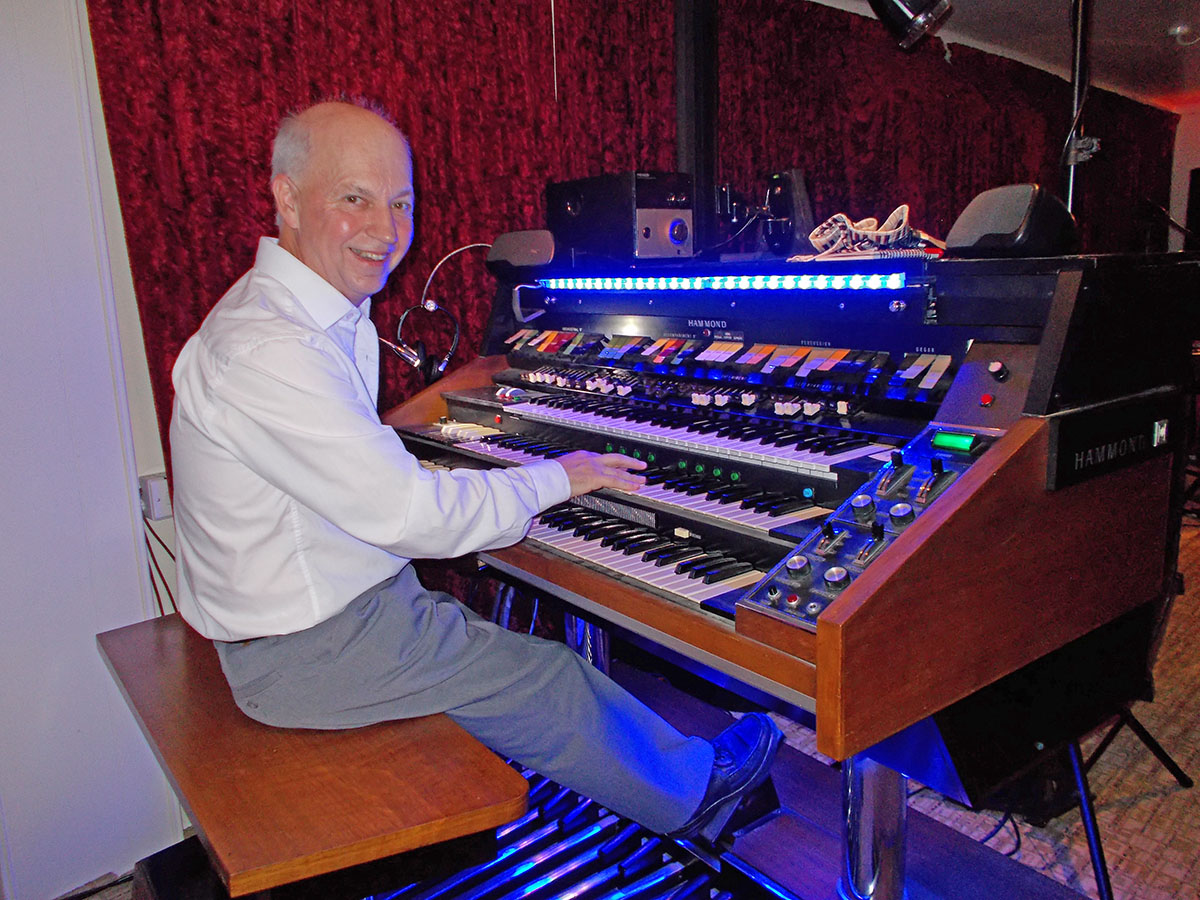
At the Hammond X-666 on the Isle of Wight
Although most of my playing is now just for fun, usually at home on my own wonderful Roland AT900 Platinum organ or Yamaha PSR-S970 keyboard, those recent concerts meant that I’ve definitely rediscovered the ‘buzz’ of playing on stage and I was due to start playing concerts on theatre pipe organ and electronics again in the summer of 2020. Alas, COVID-19 put paid to those plans but they're pencilled in again for 2022, so 'watch this space', as they say!
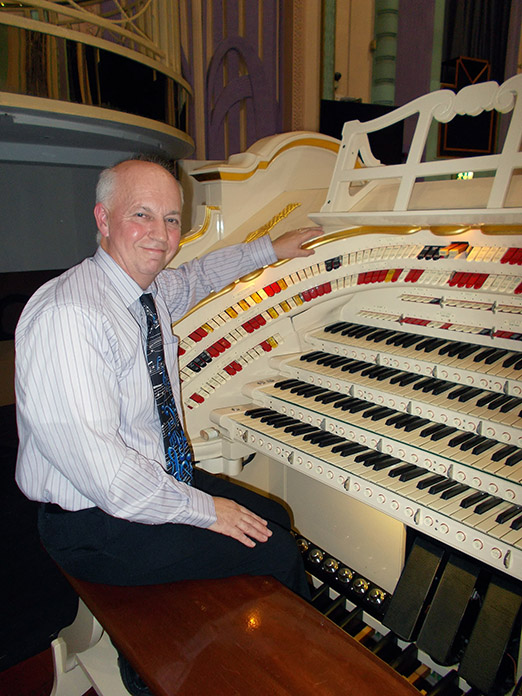
Back on pipes! At the wonderful 4-manual Wurlitzer of the Troxy, Stepney .
As well as being a regular contributor to the BBC's 'The Organist Entertains' programme, I have recorded two albums. The first was 'Wonderland by Night', on the Kawai DX900 organ and the second was 'The Swing of Things', featuring the Kawai SR6 organ, plus various Kawai keyboards and Kawai grand piano. Having recorded a fair amount of new material for on-line postings in recent years, I’ve decided to produce a CD to raise money for charity – working title “Platinum Plus” - and this is actively being worked on right now, with the Roland AT900 Platinum and Yamaha keyboards as the main instruments. Some of the AT900P and Tyros 5 tracks on the downloads page are ‘tryouts’ for possible inclusion on the CD.
I have become a regular contributor and moderator on various web forums, in particular The Organ Forum , the Yamaha Keyboard Players group and the Tierce de Picardie organ and keyboard forum. There’s also the Vintage Organ Group on Facebook and you’ll find me there most days!
Away from the world of music, over the past few years I’ve become quite involved with local history, firstly as a member of the Newhaven Historical Society and now as the chairman of the 'Our Newhaven' group. I help administrate the group’s living history website and you’ll find its red and blue ‘ON’ link on this site’s home page. I’ve recently done a few audio-visual presentations for local groups, concentrating on my own specialist subjects – the harbour, its shipping and particularly its tugs. (My father was the Master of the local harbour tug Meeching for many years and, but for the intervention of music, I’d almost certainly have followed in his footsteps.) I’ve also started writing about shipping and have had several articles published in the local press and in magazines like Ferry and Cruise Review. It’s been suggested that I write a book about the tug Meeching, based on the ‘Meeching Life History’ that I wrote for Newhaven Museum, and this is gradually taking shape, as and when time permits!
But back to the organ, and my musical tastes here are very wide-ranging. I love just about everything from classical, to theatre organ, electronic, jazz and orchestral stylings. And as far as non-organ music goes, my playlist includes almost anything from Gregorian chant, baroque masterpieces, gentle adagios for strings or romantic piano, through Big Band and swing, pop music from the 1960s, 70s and 80s, like the Beatles, the Carpenters and Abba, right through to some of the latest dance tracks, a bit of R&B and the like. I have a bit of a ‘thing’ about the music from films and shows, too.
I still consider myself to be very much a dyed-in-the-wool 'organ nut' at heart. Though almost all of my musical work revolves around pianos and keyboards these days, I still enjoy playing just about anything that has keyboards and pedals whenever I get the chance. Whether it has pipes, valves, tonewheels, transistors or microchips, I get the same buzz out of the instrument now as I did when I first heard it over 50 years ago.
Going 'straight' - Playing for a wedding.

